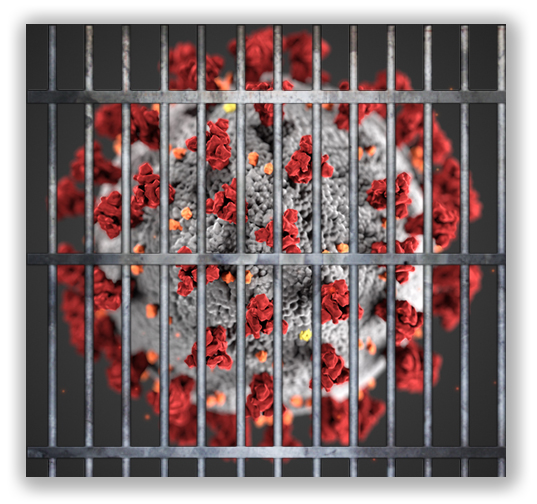We post news and comment on federal criminal justice issues, focused primarily on trial and post-conviction matters, legislative initiatives, and sentencing issues.

BARR AND THE CARES ACT
 A week ago, America had 35,000 COVID-19 cases with 40 deaths. As of this morning, the nation has over 143,000 cases and 2,052 deaths. The Federal Bureau of Prisons’ very questionable numbers, as of yesterday, showed 14 inmates and 13 staff down with the virus. The actual inmate number is undoubtedly much higher than what the BOP is willing to admit.
A week ago, America had 35,000 COVID-19 cases with 40 deaths. As of this morning, the nation has over 143,000 cases and 2,052 deaths. The Federal Bureau of Prisons’ very questionable numbers, as of yesterday, showed 14 inmates and 13 staff down with the virus. The actual inmate number is undoubtedly much higher than what the BOP is willing to admit.
On Saturday night, a low-security inmate at FCI Oakdale I, 49-year old Patrick Jones, became the BOP’s first COVID-19 death. Jones, 49, was transferred to a hospital on March 19, days before the BOP admitted to having any inmates who had tested positive for COVID-19. He was placed on a ventilator the next day. Jones, who suffered from “long-term, pre-existing medical conditions” considered risk factors for severe coronavirus illness, died Saturday at the hospital, a BOP news release said.
Last Thursday, Attorney General William Barr instructed the Bureau of Prisons to “prioritize the use of your statutory authorities to grant home confinement for inmates” in response to the virus.
That “statutory authority” got a lot broader the next day, when Congress passed The CARES Act, which President Trump signed the same day. Buried in its 373 pages is a single section devoted to the BOP. Section 12003(b)(2) provides that
(2) HOME CONFINEMENT AUTHORITY.—During the covered emergency period, if the Attorney General finds that emergency conditions will materially affect the functioning of the Bureau, the Director of the Bureau may lengthen the maximum amount of time for which the Director is authorized to place a prisoner in home confinement under the first sentence of section 3624(c)(2) of title 18, United States Code, as the Director determines appropriate.
 The “covered emergency period” began when Trump declared a national emergency and ends 30 days after he declares that the emergency has ended.
The “covered emergency period” began when Trump declared a national emergency and ends 30 days after he declares that the emergency has ended.
Under 18 USC § 3624(c)(2), the BOP can send an inmate to home confinement for not more than 10% of his or her sentence, up to a maximum of 6 months. The CARES Act provision has lifted the 10%/6-month limitation. This means that the BOP can send anyone with anything short of a life sentence to home confinement right away.
Sec. 12003 provides no guidance whatsoever as to how the BOP should pick the people to go to home confinement, or even if it should send anyone at all. However, Sec. 12003(c)(2) exempts any BOP rules on how to do it from the notice-and-comment requirements of the Administrative Procedure Act, which means the BOP can roll out its own rules immediately.
The CARES Act passage makes Barr’s Thursday memo much more important. While the only authority the BOP has to wield as of Thursday was the Elderly Offender Home Detention Program (34 USC § 60541(g)(5)), it can now move many more people. Barr’s memo specified what the BOP should consider in making its decisions:
• inmate’s age and vulnerability to COVID-19 under Centers for Disease Control and Prevention (CDC) guidelines;
• The inmate’s security level, with priority given to inmates residing in low and minimum security facilities;
• The inmate’s conduct in prison, with inmates who have engaged in violent or gang-related activity in prison or who have incurred a BOP violation within the last year not receiving priority treatment;
• The inmate’s PATTERN score, with inmates who have anything above a minimum score not receiving priority treatment;
• Whether the inmate has a “demonstrated and verifiable re-entry plan that will prevent recidivism and maximize public safety, including verification that the conditions under which the inmate would be confined upon release would present a lower risk of contracting COVID-19 than the inmate would face in his or her BOP facility;” and
• The inmate’s crime of conviction, and assessment of the danger posed by the inmate to the community.
The memo stated that “some offenses, such as sex offenses, will render an inmate ineligible for home detention. Other serious offenses should weigh more heavily against consideration for home detention.”
BOP proposes holding anyone it releases in quarantine for 14 days prior to release to home confinement.
 How much of this will happen? The devil’s in the details. The U.S. Probation Office has to approved residences for people going to home confinement, and Probation monitors people once they go home (usually with ankle monitors). There is a real possibility for a bottleneck as the U.S. Probation Office runs short of people to approve residences and of ankle monitors with which to take home confinement detainees.
How much of this will happen? The devil’s in the details. The U.S. Probation Office has to approved residences for people going to home confinement, and Probation monitors people once they go home (usually with ankle monitors). There is a real possibility for a bottleneck as the U.S. Probation Office runs short of people to approve residences and of ankle monitors with which to take home confinement detainees.
Yesterday, the Marshall Project complained that Barr’s memo blocks anyone convicted of a sex offense or violent crime from being released to home confinement. DOJ policy also bars all non-citizens convicted of immigration-related offenses from serving out their time at home. Neither “sex crime” nor “violent crime” is defined in the memo, leaving the interpretation to the BOP. Note that The CARES Act leaves implementation of expanded home confinement to the BOP’s discretion.
Of course, nothing in the Barr memo or The CARES Act limits anyone’s right – even people with sex offenses or violent crimes – to seek compassionate release under 18 USC § 3582(c)(1)(A)(i).
Washington Post, An explosion of coronavirus cases cripples a federal prison in Louisiana (Mar. 29, 2020)
William Barr, Prioritizarion of Home Confinement as Appropriate In Response to COVID-19 Pandemic (Mar. 26, 2020)
The CARES Act, H.R. 748 (signed into law Mar. 27, 2020)
The Marshall Project, How Bill Barr’s COVID-19 Prisoner Release Plan Could Favor White People (Mar 28, 2020)
– Thomas L. Root

